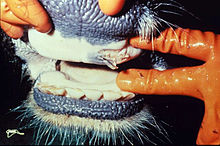| Foot-and-mouth disease | |
|---|---|
| Other names | Hoof-and-mouth disease, Aphthae epizooticae, Apthous fever |
 | |
| Ruptured oral blister in a diseased cow | |
| Specialty | Veterinary medicine |
Foot-and-mouth disease (FMD) or hoof-and-mouth disease (HMD) is an infectious and sometimes fatal viral disease that affects cloven-hoofed animals, including domestic and wild bovids.[1][2] The virus causes a high fever lasting two to six days, followed by blisters inside the mouth and near the hoof that may rupture and cause lameness.
FMD has very severe implications for animal farming, since it is highly infectious and can be spread by infected animals comparatively easily through contact with contaminated farming equipment, vehicles, clothing, and feed, and by domestic and wild predators.[3] Its containment demands considerable efforts in vaccination, strict monitoring, trade restrictions, quarantines, and the culling of both infected and healthy (uninfected) animals.

Susceptible animals include cattle, water buffalo, sheep, goats, pigs,[4][5] antelope, deer, and bison. It has also been known to infect hedgehogs and elephants;[3][6] llamas and alpacas may develop mild symptoms, but are resistant to the disease and do not pass it on to others of the same species.[3] In laboratory experiments, mice, rats, and chickens have been artificially infected, but they are not believed to contract the disease under natural conditions.[3] Cattle, Asian and African buffalo, sheep, and goats can become carriers following an acute infection, meaning they are still infected with a small amount of virus but appear healthy. Animals can be carriers for up to 1–2 years and are considered very unlikely to infect other animals, although laboratory evidence suggests that transmission from carriers is possible.[7][8]
Humans are only extremely rarely infected by foot-and-mouth disease virus (FMDV). (Humans, particularly young children, can be affected by hand, foot, and mouth disease (HFMDV), which is often confused for FMDV. Similarly, HFMDV is a viral infection belonging to the Picornaviridae family, but it is distinct from FMDV. HFMDV also affects cattle, sheep, and swine.[9])
The virus responsible for FMD is an aphthovirus, foot-and-mouth disease virus. Infection occurs when the virus particle is taken into a cell of the host. The cell is then forced to manufacture thousands of copies of the virus, and eventually bursts, releasing the new particles in the blood. The virus is genetically highly variable,[10] which limits the effectiveness of vaccination. The disease was first documented in 1870.
- ^ Arzt, J.; Juleff, N.; Zhang, Z.; Rodriguez, L. L. (2011). "The Pathogenesis of Foot-and-Mouth Disease I: Viral Pathways in Cattle". Transboundary and Emerging Diseases. 58 (4): 291–304. doi:10.1111/j.1865-1682.2011.01204.x. PMID 21366894.
- ^ Arzt, J.; Baxt, B.; Grubman, M. J.; Jackson, T.; Juleff, N.; Rhyan, J.; Rieder, E.; Waters, R.; Rodriguez, L. L. (2011). "The Pathogenesis of Foot-and-Mouth Disease II: Viral Pathways in Swine, Small Ruminants, and Wildlife; Myotropism, Chronic Syndromes, and Molecular Virus-Host Interactions". Transboundary and Emerging Diseases. 58 (4): 305–326. doi:10.1111/j.1865-1682.2011.01236.x. PMID 21672184.
- ^ a b c d "Canadian Food Inspection Agency – Animal Products – Foot-and-Mouth Disease Hazard Specific Plan". Archived from the original on June 5, 2008.
- ^ Stenfeldt, C.; Pacheco, J.M.; Rodriguez, L.L.; Arzt, J. (2014). "Infection dynamics of foot-and-mouth disease virus in pigs using two novel simulated-natural inoculation methods". Research in Veterinary Science. 96 (2): 396–405. doi:10.1016/j.rvsc.2014.01.009. PMID 24548596.
- ^ Stenfeldt, Carolina; Pacheco, Juan M.; Rodriguez, Luis L.; Arzt, Jonathan (2014). "Early Events in the Pathogenesis of Foot-and-Mouth Disease in Pigs; Identification of Oropharyngeal Tonsils as Sites of Primary and Sustained Viral Replication". PLOS ONE. 9 (9): e106859. Bibcode:2014PLoSO...9j6859S. doi:10.1371/journal.pone.0106859. PMC 4153717. PMID 25184288.
- ^ McLauchlan, J. D.; Henderson, W. M. (1947). "The Occurrence of Foot-and-Mouth Disease in the Hedgehog under Natural Conditions". The Journal of Hygiene. 45 (4): 474–479. doi:10.1017/s0022172400014194. PMC 2235060. PMID 18910334.
- ^ Stenfeldt, Carolina; Arzt, Jonathan (28 February 2020). "The Carrier Conundrum; A Review of Recent Advances and Persistent Gaps Regarding the Carrier State of Foot-and-Mouth Disease Virus". Pathogens. 9 (3): 167. doi:10.3390/pathogens9030167. PMC 7157498. PMID 32121072.
- ^ Arzt, Jonathan; Belsham, Graham J.; Lohse, Louise; Bøtner, Anette; Stenfeldt, Carolina (12 September 2018). "Transmission of Foot-and-Mouth Disease from Persistently Infected Carrier Cattle to Naive Cattle via Transfer of Oropharyngeal Fluid". mSphere. 3 (5): e00365–18, /msphere/3/5/mSphere365–18.atom. doi:10.1128/mSphere.00365-18. PMC 6135961. PMID 30209130.
- ^ "Hand, Foot, and Mouth Disease (HFMD)". Centers for Disease Control and Prevention (CDC). 2019-02-22. Retrieved 28 August 2019.
- ^ Martinez-Salas E, Saiz M, Sobrino F (2008). "Foot-and-Mouth Disease Virus". Animal Viruses: Molecular Biology. Caister Academic Press. pp. 1–38. ISBN 978-1-904455-22-6. Archived from the original on 2012-02-07. Retrieved 2007-08-10.